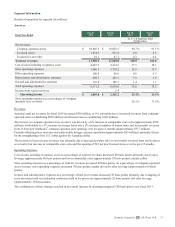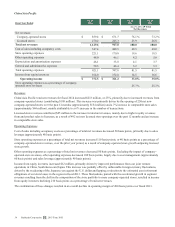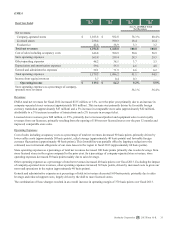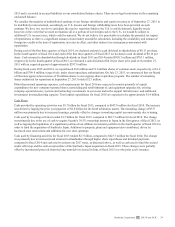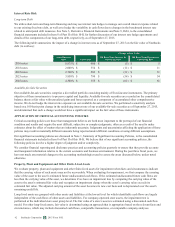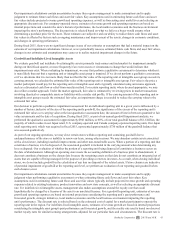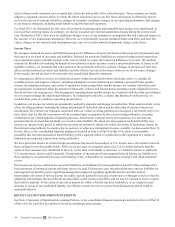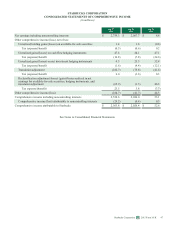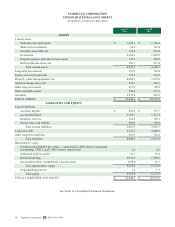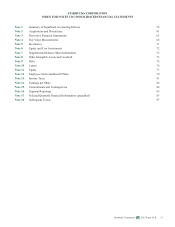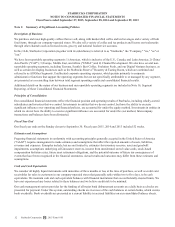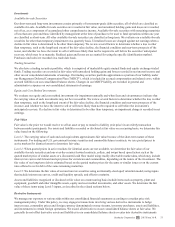Starbucks 2015 Annual Report Download - page 47
Download and view the complete annual report
Please find page 47 of the 2015 Starbucks annual report below. You can navigate through the pages in the report by either clicking on the pages listed below, or by using the keyword search tool below to find specific information within the annual report.
Our impairment calculations contain uncertainties because they require management to make assumptions and to apply
judgment to estimate future cash flows and asset fair values. Key assumptions used in estimating future cash flows and asset
fair values include projected revenue growth and operating expenses, as well as forecasting asset useful lives and selecting an
appropriate discount rate. For company-operated stores, estimates of revenue growth and operating expenses are based on
internal projections and consider the store’s historical performance, the local market economics and the business environment
impacting the store’s performance. The discount rate is selected based on what we believe a buyer would assume when
determining a purchase price for the store. These estimates are subjective and our ability to realize future cash flows and asset
fair values is affected by factors such as ongoing maintenance and improvement of the assets, changes in economic conditions,
and changes in operating performance.
During fiscal 2015, there were no significant changes in any of our estimates or assumptions that had a material impact on the
outcome of our impairment calculations. However, as we periodically reassess estimated future cash flows and asset fair values,
changes in our estimates and assumptions may cause us to realize material impairment charges in the future.
Goodwill and Indefinite-Lived Intangible Assets
We evaluate goodwill and indefinite-lived intangible assets (primarily trade names and trademarks) for impairment annually
during our third fiscal quarter, or more frequently if an event occurs or circumstances change that would indicate that
impairment may exist. When evaluating for impairment, we may first perform a qualitative assessment to determine whether it
is more likely than not that a reporting unit or intangible asset group is impaired. If we do not perform a qualitative assessment,
or if we determine that it is not more likely than not that the fair value of the reporting unit or intangible asset group exceeds its
carrying amount, we calculate the estimated fair value of the reporting unit or intangible asset group. Fair value is the price a
market participant would pay for the reporting unit or intangible asset and is typically calculated using an income approach,
such as a discounted cash flow or relief-from-royalty method. For certain reporting units, where deemed appropriate, we may
also utilize a market approach. Under the market approach, fair value is estimated by reviewing prices in market transactions
involving identical or comparable assets or liabilities with a similar risk profile. If the carrying amount of the reporting unit or
intangible asset group exceeds the estimated fair value, an impairment charge is recorded to reduce the carrying value to the
estimated fair value.
Our decision to perform a qualitative impairment assessment for an individual reporting unit in a given year is influenced by a
number of factors, inclusive of the size of the reporting unit's goodwill, the significance of the excess of the reporting unit's
estimated fair value over carrying value at the last quantitative assessment date, the amount of time in between quantitative fair
value assessments and the date of acquisition. During fiscal 2015, as part of our annual goodwill impairment analysis, we
performed the qualitative assessment for approximately $941 million, or 60%, of our total goodwill balance of $1.6 billion, the
majority of which resides in our Japan retail, U.S. company-operated and Canada company-operated reporting units. Our Japan
retail reporting unit, which was acquired in fiscal 2015, represented approximately $730 million of the goodwill balance that
was assessed qualitatively.
As part of our ongoing operations, we may close certain stores within a reporting unit containing goodwill due to
underperformance of the store or inability to renew our lease, among other reasons. We may abandon certain assets associated
with a closed store, including leasehold improvements and other non-transferable assets. When a portion of a reporting unit that
constitutes a business is to be disposed of, the associated goodwill is included in the carrying amount when determining any
loss on disposal. Our evaluation of whether the portion of a reporting unit being disposed of constitutes a business occurs on
the date of abandonment. Although an operating store meets the accounting definition of a business prior to abandonment, it
does not constitute a business on the closure date because the remaining assets on that date do not constitute an integrated set of
assets that are capable of being managed for the purpose of providing a return to investors. As a result, when closing individual
stores, we do not include goodwill in the calculation of any loss on disposal of the related assets. If store closures are indicative
of potential impairment of goodwill at the reporting unit level, we perform an evaluation of our reporting unit goodwill when
such closures occur.
Our impairment calculations contain uncertainties because they require management to make assumptions and to apply
judgment when performing a qualitative assessment or when estimating future cash flows and asset fair values. Key
assumptions used in estimating future cash flows and asset fair values typically include projected revenue growth and operating
expenses related to existing businesses, product innovation and new store concepts, as well as selecting an appropriate discount
rate. For indefinite-lived intangible assets, management also makes assumptions around the royalty rate that could
hypothetically be charged by a licensor of the asset to an unrelated licensee. For a goodwill reporting unit, estimates of revenue
growth and operating expenses are based on internal projections considering the reporting unit’s past performance and
forecasted growth, strategic initiatives, local market economics and the local business environment impacting the reporting
unit’s performance. The discount rate is selected based on the estimated cost of capital for a market participant to operate the
reporting unit in the region. For indefinite-lived intangible assets, estimates of revenue growth are based on internal projections
considering the intangible asset group's past performance and forecasted growth, and the royalty rate used is based on observed
market royalty rates for similar licensing arrangements, adjusted for our particular facts and circumstances. The discount rate is
Starbucks Corporation 2015 Form 10-K 43


